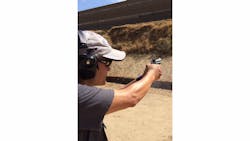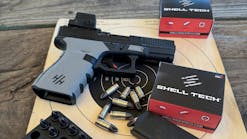Bond Arms: Your third gun
I tested the Bond Arms Big Bear double barrel derringer in 45 Colt. The Big Bear is similar to the Bond Arms Backup, a gun I anticipate to be popular as a third gun for law enforcement.
I’m going to talk about the hand made quality in a minute. Before that, the reader needs to hear about the intangible part of Bond Arms. Everyone likes products that last, but not every consumer can afford the hand made knife, the expensive sports car or the well made watch. People buy the Bond Arms Guns for their utility, but many purchase them just to own them. The parts fit together with a hand feel that makes the Bond Arms Gun feel commissioned, not manufactured.
What is evidence of this mystique? I can go to the range and lay out all the guns I’m shooting that day. Invariably, other shooters with me want to handle the Big Bear and the Brown Bear. There is something about them, and few can describe it. Bond Arms makes over a dozen models with interchangeable barrels. There are over 20 calibers from which to choose. That’s correct: One can get a base model and switch barrels, a one minute process, and have a different gun altogether. The Big Bear and the Brown Bear, designated for sales in California, are the only models that cannot swap barrels. The type of gun that is becoming most popular is the 45 LC/410 Shotgun combination. My favorite Bond Arms model is the Ranger II in 45/410.
The Big Bear comes in 45 Colt, or as I still call it, 45 Long Colt (45 LC). The 45 LC has enjoyed a 141-year history as a military and occasional law enforcement cartridge. Most shooters theorize that the 45 LC would have such an offensive recoil in the Big Bear that it would be unmanageable. This is absolutely incorrect, but we’ll get into that later.
The American firearms manufacturing industry is at its finest right now and the increase in firearms laws have only improved the industry. Not only have consumers created a demand in the quantity of guns nationwide, the average consumer is also driving up the quality. The evidence is in the gun store, where mass produced firearms now reflect the quality of slow production products 20 years ago. The best example I have seen is the dramatic improvement in the quality of handguns like the Charter Arms revolvers and Smith and Wesson autos.
All Bond Arms guns are made with modern manufacturing processes that include old world craftsmanship. Bond Arms Guns are made in Granbury Texas, using parts made in the United States. The guns are made entirely of stainless steel and other parts that complete the package like the grips are also made in the US. The Bond Arms brand has only been around since 1995. They took an ancient design-the Remington Model 95, which was first released in 1865, and modernized it. This is an interesting approach as derringers have a long history of being cheap, one time use, inaccurate guns.
The Big Bear weighs just shy of 20 ounces, unloaded. It has a 3-inch barrel, which is quite short for a cartridge that can have an overall length of 1.60 inches. It has a satin stainless barrel and a textured subdued frame. The stocks are made of a soft rubber. It is heavier than it looks and the stocks completely fill the hand. The Brown Bear is essentially the same model with the same dimensions, except it is not matte finish. The stocks are hardwood and they sport the same logo in the grip, only it is carved, not moulded.
Let me dispel the first reservation that a future shooter would have about my gun. Since the top barrel sits only slightly higher than the web of the hand, and the bottom barrel is actually at the level of the palm, it has comparatively light recoil. Yes, you didn’t mis-read it: The Bond Arms Derringer barely kicks. I would compare it to a compact 9mm auto.
Let’s put this in perspective. For 141 years, no one ever has described the 45 LC as an “inadequate” cartridge. For this test, I used cartridges that ran from 255-300 grains, fired at 700-800 feet per second. The bullets are twice the weight of a 9mm duty round and about the same number of foot pounds of energy, even considering the short barrel. They expand to several times the expansion of a 9mm, resulting in similar cartridge performance of any modern duty round, even with 3 inches of barrel.
For the officer who carries this gun as the third gun, I recommend the Hornady 185 gr FTX Critical Defense cartridge. It was designed for (and tested in) a 3-inch barrel, which gets it up to 920 fps.
What do I mean by a “third gun”? Most officers will carry a backup gun. A third gun is the one carried for unusual circumstances. It has to be completely reliable, impervious to the elements (including sweat) and effective. The most important thing a third gun has to be is simple. The firing mechanism has to contain the fewest moving parts and it must be immune to cartridge failure. Bond Arms guns have simple firing and loading mechanisms. Not only are they easy to use, they are completely safe to carry in unconventional methods and can be brought into action quickly.
I prefer to carry guns with which I can make a shot designed to rescue a hostage. I define this shot as a reliable headshot at 7 yards. Some of my guns like my Glock 22 can consistently make the same shot at 25 yards, but pocket guns have to do it at 7. My philosophy behind this is from knowing other officers who needed to make an off duty OIS. Most of them did not have a fully exposed target. Seven yards is about the limit of the accuracy of my Bond Arms Big Bear. Granted, it was definitely capable of much better accuracy, except for one thing. One barrel shot low and the other high. At 7 yards, this became noticeable. The rounds that shot low and high grouped in tight groups consistently, a testimony of the inherent accuracy of the design. I have to qualify with my guns. On a B-27 target at 15 yards, I can land groups all day with my Big Bear. I just couldn't trust my headshot under stress beyond 7 yards, which must be under 4 inches.
The Bond Arms gun is inherently safe, beginning with the fact that it will not fire unless the trigger is pulled all the way to the rear and the cross bolt safety is off. One fires it by pulling back on the hammer and squeezing the trigger. Cocking the hammer is about 40 degrees. My gun uses a rebounding and locking hammer. At rest, the hammer cannot go forward. It cannot contact the firing pins unless the trigger is pulled. This means that it cannot fire even if dropped with the safety off.
Loading is easy. There is a spring loaded lever parallel with the barrel. Pressing downward releases the barrel. The spring loaded extractors pop the barrel upwards slightly while starting the extraction of spent rounds. The extractor has an external lever to allow the shooter to continue the extraction. This is another safety. Popping the barrel prevents the firing pins from contacting anything. The gun cannot fire out of battery. One swings the barrels all the way around and to remove the spent rounds. Two rounds are inserted into the chambers and the user swings the barrels around to their closed position. I found that it was easy to get into a cadence of loading and firing. I would reach over the top of the barrels with my left hand and release the barrels with my thumb. Instead of rotating the barrels, I would rotate the receiver, while thumbing the extractors. Still holding the barrels, I would grab two round from a holder, pinching them between thumb and fingers. The fingertips begin to guide the rounds into the barrel. Once seated, the gun is snapped shut. As shooters get better, reloads are a matter of seconds.
There is one aspect of the Bond Arms that I didn’t like. I don’t like the trigger guard. Most of the shooters did, but I like an exposed trigger on a derringer. The good news is that it is designed to be removable, simply by removing the screw that secures it.
I got plenty of time behind my Big Bear. The 45 LC is very easy to reload and it will take a variety of loads. I even have several loads from the bullets I pour myself. Commercially, there are several products available designed as an optimistic defense against dangerous North American game. I won’t try that one yet, but commercially available practice rounds are not hard to find. Using 255 Grain LRN cartridges, I fired off 50 rounds in a leisurely range session. Who would have thought that this gun was actually comfortable to shoot?
Bond Arms Guns have interchangeable barrels, which allow officers to adhere to the “same caliber” philosophy. That is, if you carry a 40S&W for duty, your backup should be the sam caliber. If you are a Bond Arms user, I recommend that you practice loading the gun from the duty magazine, which might speed things up a bit. It is simply a matter of feeding a round into the chamber from the magazine. Remember that this design favors rimmed cartridges however, due to the extractor design.
When we look at Bond Arms Guns, we cannot overlook the use of shotgun rounds for snake protection. I’m all for officers hiking on their off duty time.
These are some of the most interesting products in the industry today. Consider them for the third gun.

Officer Lindsey Bertomen (ret.), Contributing Editor
Lindsey Bertomen is a retired police officer and retired military small arms trainer. He teaches criminal justice at Hartnell College in Salinas, California, where serves as a POST administrator and firearms instructor. He also teaches civilian firearms classes, enjoys fly fishing, martial arts, and mountain biking. His articles have appeared in print and online for over two decades.



